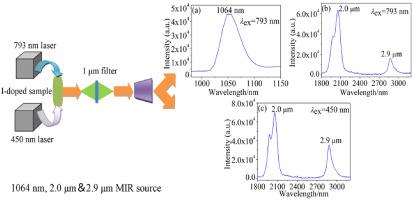Journal of Rare Earths ( IF 5.2 ) Pub Date : 2020-10-16 , DOI: 10.1016/j.jre.2020.10.004 Hao Yin , Xiaosong Zhang , Lan Li , Jiajia Zhang , Zhaowei Zhang , Xin Liu , Xiaokai Gong , Rukun Ding

|
Ho3+ doped ZBLAN glass with 2.0 and 2.9 μm emission was prepared. In order to further improve the luminescence of Ho3+, halogen ions (Cl, Br, I) were introduced to reduce the maximum phonon energy and phonon state density of the sample. At the same time, Nd3+ was introduced to transfer the energy to Ho3+ pumped with a 793 nm laser (Nd3+:4F5/2,4F3/2→Ho3+:5I6). The effect of different halogen ion on the luminescent properties of the fluoride halide glass was compared. The results show that the luminescent intensity of infrared increases with the introduction of different halogen ions. By comparison, it is found that the sample with I– has the strongest luminescence of 1064 nm, 2.0 μm and 2.9 μm. This is consistent with the calculated J-O intensity parameters. In addition, the 2.0 and 2.9 μm emission of Ho3+ pumped with a 450 nm laser will not disappear. A mid-infrared sample with multi-wavelength excitation and multi-wavelength emission can be obtained. Nd3+/Ho3+ co-doped fluoride halide glasses with 1064 nm, 2.0 μm and 2.9 μm luminescence were prepared by melt quenching method. The luminescent mechanism and the energy transfer process between the two ions of Nd3+/Ho3+ co-doped fluoride halide glass were studied. The J-O parameters, luminescence lifetime and absorption emission cross-sectional area of Ho3+ and Nd3+ were calculated, respectively. It is found that the value of Ω2 in the glass matrix increases with the introduction of different halogen ions, while Ω4 and Ω6 do not change obviously in different glass compositions. This is because the environment of the crystal field around the rare earth ions changes. The crystal phase and phonon energy of the sample were analyzed by X-ray diffraction pattern and a Fourier transform infrared spectrometer, respectively. Based on the above spectra and data (phonon energy is 634.71 cm−1), it can be predicted that Nd3+/Ho3+ co-doped fluoride halide glass is a potential mid-infrared luminescent material.
中文翻译:

阴离子取代多波长可调中红外发光Nd3+/Ho3+共掺杂氟卤化物玻璃的能量转移过程
制备了具有 2.0 和 2.9 μm 发射的Ho 3+掺杂 ZBLAN 玻璃。为了进一步提高Ho 3+的发光,引入卤素离子(Cl、Br、I)来降低样品的最大声子能量和声子态密度。同时,引入Nd 3+将能量转移到用 793 nm 激光泵浦的Ho 3+ (Nd 3+ : 4 F 5/2 , 4 F 3/2 →Ho 3+ : 5 I 6)。比较了不同卤离子对氟卤化物玻璃发光性能的影响。结果表明,红外发光强度随着不同卤素离子的引入而增加。通过比较,可以发现,与我的样品-具有1064纳米,2.0微米和2.9微米的最强发光。这与计算的 JO 强度参数一致。此外,用 450 nm 激光泵浦的 Ho 3+的 2.0 和 2.9 μm 发射不会消失。可以获得具有多波长激发和多波长发射的中红外样品。钕3+ /Ho 3+采用熔融淬火法制备了具有1064 nm、2.0 μm和2.9 μm发光的共掺杂氟卤化物玻璃。研究了Nd 3+ /Ho 3+共掺杂氟卤化物玻璃两种离子之间的发光机理和能量传递过程。分别计算了Ho 3+和Nd 3+的JO参数、发光寿命和吸收发射截面积。发现玻璃基体中Ω 2的值随着不同卤素离子的引入而增加,而Ω 4和Ω 6不同玻璃成分变化不明显。这是因为稀土离子周围的晶场环境发生了变化。样品的晶相和声子能量分别通过 X 射线衍射图和傅里叶变换红外光谱仪进行分析。基于上述光谱和数据(声子能量为634.71 cm -1),可以预测Nd 3+ /Ho 3+共掺杂氟卤化物玻璃是一种潜在的中红外发光材料。









































 京公网安备 11010802027423号
京公网安备 11010802027423号